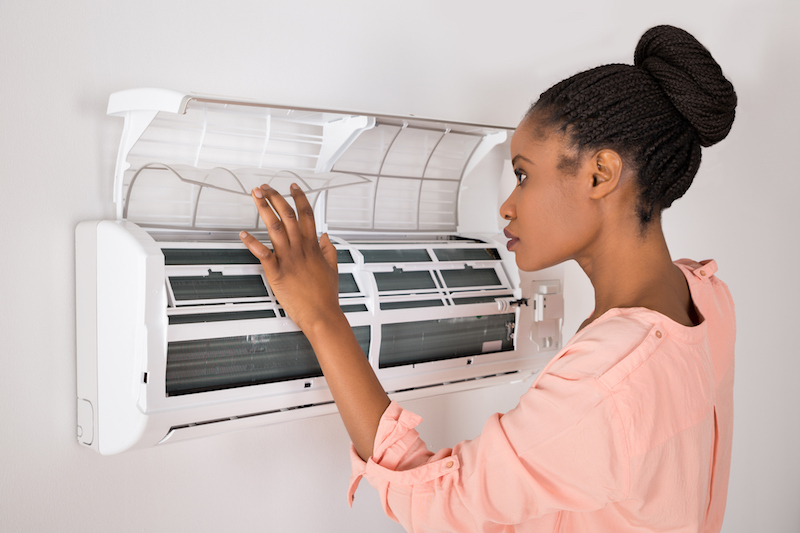
You shouldn’t need to sacrifice comfort or spend a lot to keep your residence at a refreshing setting during warm days.
But what is the ideal setting, exactly? We go over suggestions from energy experts so you can determine the best temperature for your loved ones.
Here’s what we suggest for the most energy-efficient setting for air conditioning in Rockford.
Recommended Thermostat Settings for Summer
Most families find using the thermostat at 72-73 degrees is most comfortable. However, if there’s a major difference between your interior and exterior temperatures, your electrical bills will be larger.
This is our advice based on the U.S. Department of Energy (DOE) and ENERGY STAR®.
While at home: 78 degrees. While that appears too high, there are ways you can keep your residence cool without having the air conditioner running constantly.
Keeping windows and window treatments closed during the day keeps cold air where it needs to be—within your home. Some window solutions, such as honeycomb shades or plantation shutters, are created to provide more insulation and enhanced energy efficiency.
If you have ceiling fans in your house, the DOE says you can raise thermostat temperatures about 4 degrees warmer without sacrificing comfort. That’s because they freshen with a windchill effect. As they cool people, not areas, switch them off when you leave a room.
If 78 degrees still feels too warm at first glance, try running a trial for a week or so. Get started by raising your thermostat to 78 degrees while you’re at your house. Then, steadily turn it down while following the suggestions above. You may be surprised at how comfortable you feel at a warmer temperature setting.
While away: 88 degrees. There’s no reason to keep the AC working all day while your residence is unoccupied. Turning the temperature 7–10 degrees warmer can save you an estimated 5–15% on your AC costs, according to the DOE.
When you arrive home, don’t be tempted to switch your thermostat under 78 to cool your residence more rapidly. This isn’t productive and usually leads to a higher cooling bill.
A programmable thermostat is a useful method to keep your temperature controlled, but you have to set programs. If you don’t set programs, you run the risk of forgetting to increase the set temperature when you go.
If you need a convenient resolution, consider buying a smart thermostat. This thermostat connects with your phone, so it is aware when you’re at your residence and when you’re away. Then it intuitively changes temperature settings for the best savings. How much exactly? Typically $180 each year on heating and cooling, according to ENERGY STAR.
Another perk of using a smart thermostat? You can use your phone to keep an eye on and change temperature settings from nearly anywhere.
While sleeping: Around 70 degrees. While ENERGY STAR advises 82 degrees, that could be too uncomfortable for many families. Most people sleep better when their bedroom is cold, so that’s why the National Sleep Foundation advises 60–67 degrees. But that may be too cold, based on your clothing and blanket preference.
We advise running a similar test over a week, putting your thermostat higher and gradually decreasing it to select the right setting for your residence. On mild nights, you might find keeping windows open at night and using a ceiling fan is a better option than operating the air conditioner.
More Approaches to Conserve Energy During Hot Weather
There are other methods you can conserve money on utility bills throughout hot weather.
- Get an energy-efficient cooling system. Central air conditioners only work for about 12–15 years and become less efficient as they become older. A new air conditioner can keep your house cooler while keeping electricity bills small.
- Set regular air conditioner maintenance. Routine air conditioner maintenance keeps your unit running properly and might help it operate at better efficiency. It might also help prolong its life expectancy, since it allows pros to find little issues before they create a major meltdown.
- Change air filters frequently. Follow manufacturer instructions for replacing your air filter. A dirty filter can result in your system short cycling, or switch on and off too often, and drive up your electricity.
- Measure attic insulation levels. Almost 90% of homes in the U.S. don’t have enough insulation, according to the Insulation Institute. The majority of southern climates should have 13–14” of attic insulation, while northern climates need 16–18”.
- Have your ductwork inspected. Ductwork that has separated over time can leak cold air into your attic, walls or crawl space. This can lead to big comfort issues in your home, like hot and cold spots.
- Seal cracks, doors and windows. Keep muggy air where it belongs by sealing cracks. You can also caulk or weather strip doors to seal more cold air within your home.
Save More Energy During Warm Weather with Temperature Doctors Heating & Cooling
If you are looking to conserve more energy during hot weather, our Temperature Doctors Heating & Cooling experts can assist you. Reach us at (815) 914-6197 or contact us online for extra info about our energy-saving cooling products.
